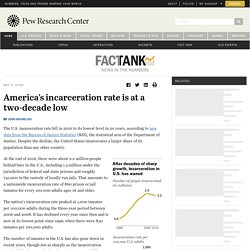

U.S. incarceration rate is at its lowest in 20 years. The U.S. incarceration rate fell in 2016 to its lowest level in 20 years, according to new data from the Bureau of Justice Statistics (BJS), the statistical arm of the Department of Justice.

Despite the decline, the United States incarcerates a larger share of its population than any other country. At the end of 2016, there were about 2.2 million people behind bars in the U.S., including 1.5 million under the jurisdiction of federal and state prisons and roughly 741,000 in the custody of locally run jails. That amounts to a nationwide incarceration rate of 860 prison or jail inmates for every 100,000 adults ages 18 and older. The nation’s incarceration rate peaked at 1,000 inmates per 100,000 adults during the three-year period between 2006 and 2008. Mass Incarceration: The Whole Pie 2019. By Wendy Sawyer and Peter Wagner March 24, 2020Press release Can it really be true that most people in jail are being held before trial?
This is a great resource to prove we need reform- people being detained pre-trial is adding to the increased number of people in our prison system. – jls06e
And how much of mass incarceration is a result of the war on drugs?

These questions are harder to answer than you might think, because our country’s systems of confinement are so fragmented. The various government agencies involved in the justice system collect a lot of critical data, but it is not designed to help policymakers or the public understand what’s going on. As public support for criminal justice reform continues to build, however, it’s more important than ever that we get the facts straight and understand the big picture.
This report offers some much needed clarity by piecing together this country’s disparate systems of confinement. Criminal Justice Facts. There are 2.2 million people in the nation’s prisons and jails—a 500% increase over the last 40 years.

Changes in law and policy, not changes in crime rates, explain most of this increase. The results are overcrowding in prisons and fiscal burdens on states, despite increasing evidence that large-scale incarceration is not an effective means of achieving public safety. International Rates of Incarceration per 100,000 Denma… Data source: Institute for Crime & Justice Policy Research. U.S. Wrongful Convictions. When Paul House was finally released from prison in 2008, he was a specter of the man who had been sentenced to death more than 22 years earlier.

When I visit his home in Crossville, Tennessee, in March, House’s mother Joyce, who has cared for him since his release, points to a photo of House taken the day he was finally allowed to come home. In that photo and others from his last days in prison, House is all of 150 pounds, ashen and drawn, his fragile frame nearly consumed by his wheelchair. In most of the images he looks days away from death, although in one he wears the broad smile of a man finally escaping a long confinement.
When House’s aunt called to congratulate him on his first day back, his mother handed him her cell phone so he could chat. He inspected the phone, gave her a frustrated look, and asked her to find him one that worked. “Paul’s first meal when he got home was chili verde,” Joyce House says. The years of inadequate care have taken a toll. Another innocent executed? The only evidence against DeLuna was the shoddy eyewitness testimony of Kevin Baker, a car salesman who came face to face with Lopez’s killer as he fled the scene.
Although DeLuna partly resembled the description given by Baker, upon further investigation it seems that DeLuna and the man Baker described were not the same person. For example, Baker told police that the culprit had a full mustache and so much facial hair that he looked like “he hadn’t shaved in, you know, ten days, a couple weeks.” When police found DeLuna, he was lying half naked, shoeless and shirtless, underneath a pickup truck with little more than a day or two of stubble and no mustache. DeLuna testified that he was at the nightclub across the street from the crime scene trying to find a ride home when the sound of police sirens freaked him out because he was on parole at the time. What Is Restorative Justice / Restorative Justice Council. Restorative practice in communities resolves conflict before it turns into crime and builds community ownership of solutions.

Restorative practices in communities resolve conflicts and neighbour disputes before they escalate into crime. It is an effective approach to dealing with anti-social behaviour, graffiti, noise and criminal damage, enabling people to understand the impact of their behaviour on others. For victims of anti-social behaviour it delivers effective outcomes owned by the local community, and reduces the fear of crime.
Restorative practices have also been used to deal with gang-related conflicts. Restorative approaches in communities include a range of models including community mediation; police and community support officers using restorative skills on the street; and Community Justice Panels - an innovative community based delivery model being used in Sheffield and in South Somerset. CLOSED COURTROOMS only protect bad judges and bad lawyers, said US Judge Judy in Ireland. Tough Sentences Help Prosecutors Push for Plea Bargains.
Criminal Justice Reform. Top Trends in State Criminal Justice Reform, 2019. A family is reunited after more than 400 Oklahomans were approved for expedited commutations in November 2019.

Photo Credit: Oklahomans for Criminal Justice Reform The United States is a world leader in incarceration and keeps nearly 7 million persons under criminal justice supervision. More than 2.2 million are in prison or jail, while 4.6 million are monitored in the community on probation or parole. More punitive sentencing laws and policies, not increases in crime rates, have produced this high rate of incarceration. Ending mass incarceration will require changing sentencing policies and practices, scaling back the collateral consequences of conviction, and addressing racial disparities in the criminal justice system. Reducing Prison Populations Through Sentencing Reform California lawmakers passed Senate Bill 136 to repeal the one-year sentence enhancement for each prior prison or county jail felony term. Expanding the Vote. Criminal Justice Reform.